It is going to be hot, hot, hot this weekend. Forecasts are showing triple digits for Saturday-Monday, with a high of 104 for Monday. Be careful in this heat and stay hydrated. Crops in the county are looking really good after some needed showers this week, and looking at the forecast they are calling for more showers next week. I am seeing hits of white mold in peanuts in fields across the county so I highly recommend to take a look at your fields and if white mold is present to make necessary adjustments to your fungicide program, see comments from Dr. Kemerait further in this update. A potential new pest of cotton and peanuts has been detected in Appling County this week, do not go firing up the sprayers though, UGA Extension is still learning about this pest and is currently surveying counties/fields for this insect, see Dr. Roberts comments on the Cotton Jassid further in this update.
Topics in this Newsletter Include:
- July Peanut Pointers (UGA Peanut Team)
- Row Crop Disease Update (Dr. Bob Kemerait, UGA Plant Pathologist)
- Cotton Jassid (Dr. Phillip Roberts, UGA Cotton Entomologist)
- Recent Peanut Problems (Copperleaf, Roundup, Mixing Order, 2,4-DB Rain-Free Period) (Dr. Eric Prostko, UGA Weed Specialist)
- Grains Team | Social Media | Outreach & Educational Programming (Dr. Nick Shay, UGA Grains Agronomist)
- Midville Field Day (SEREC)
- All About the Pod Podcast (UGA Peanut Team)
- Talkin’ Cotton Podcast (UGA Cotton Team)
July Peanut Pointers (UGA Peanut Team)
Row Crop Disease Update (Dr. Bob Kemerait, UGA Plant Pathologist)
Stemphylium Leaf Spot of Cotton
These are symptoms of Stemphylium leaf spot (Stremphylium solani). As the genesis of Stemphylium leaf spot is Potassium deficiency in the plant which makes the cotton susceptible, a fungicide program won’t help here. Potassium deficiencies can occur for a number of reasons and must be corrected to manage this disease and mitigate premature defoliation and subsequent yield loss.
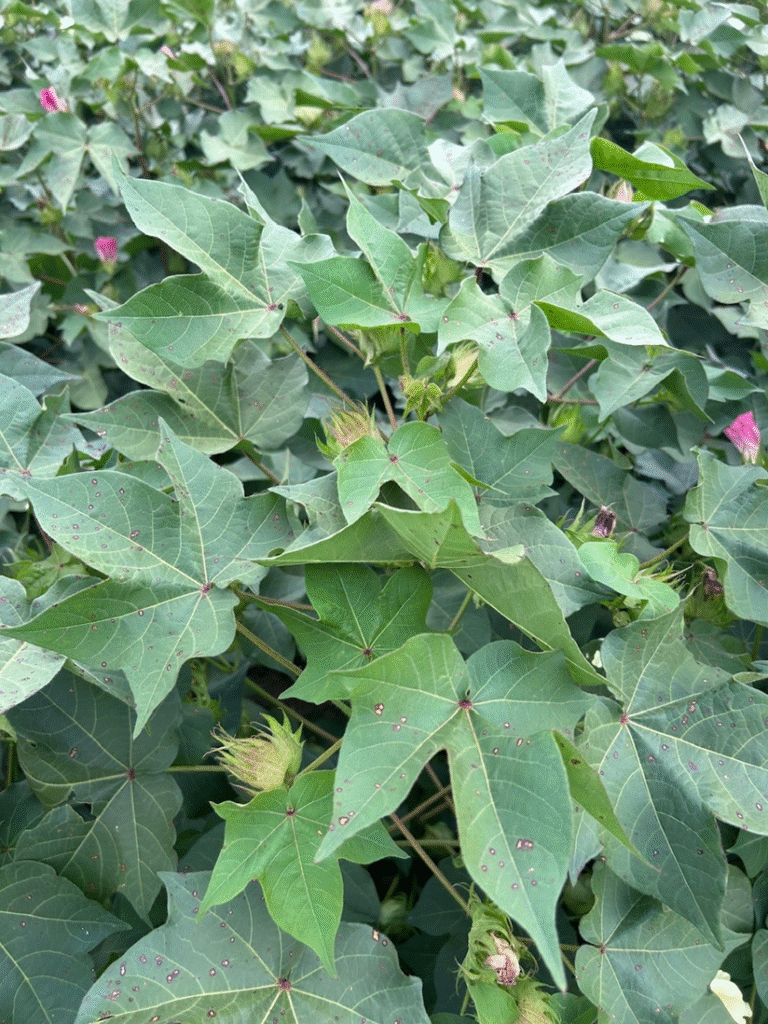
Not Stemphylium Leaf Spot of Cotton
I think in this case what we have here is some sort of burn. Note the splotchy nature of the spots; the spots seem to be in the lower leaves and not on all plants, the grass weeds seem like they have been sprayed with something AND the cotton leaves are not showing the classic reddening associated with potassium deficiency.
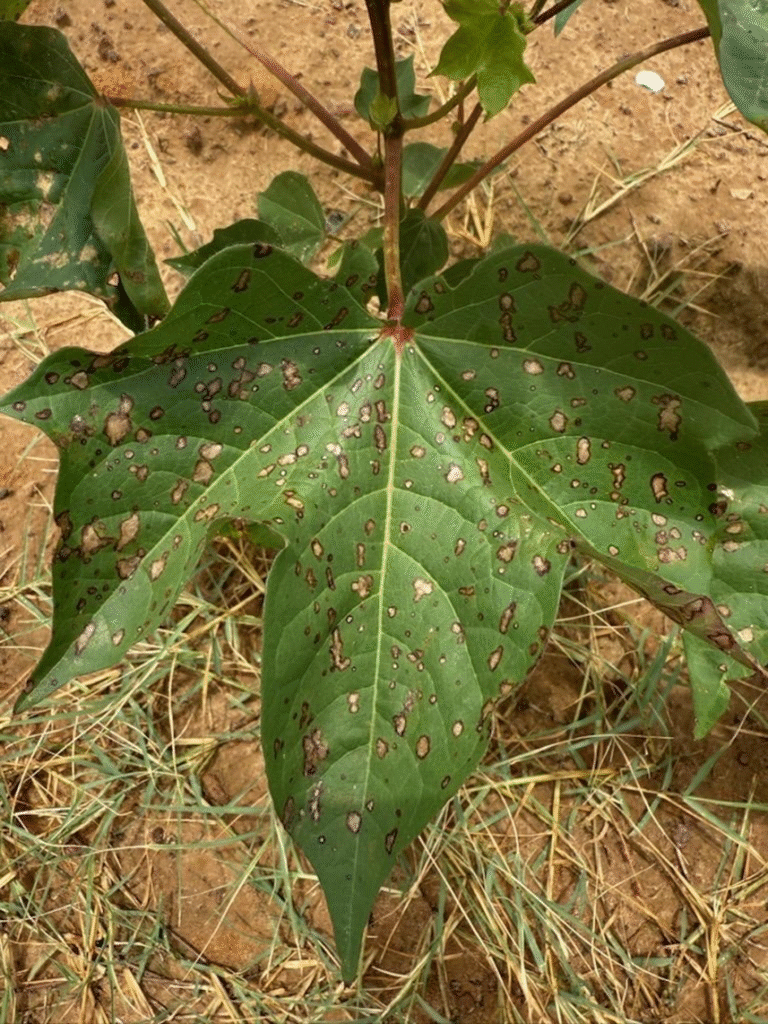
TSWV in Peanut
Note the necrotic taproot with brown vascular discoloration. Note the caramel-slick color of some of the pods. This is tomato spotted wilt virus on peanut. We most often diagnose this disease by stunting and foliar symptoms, but these root and pod symptoms are very clear symptoms as well.
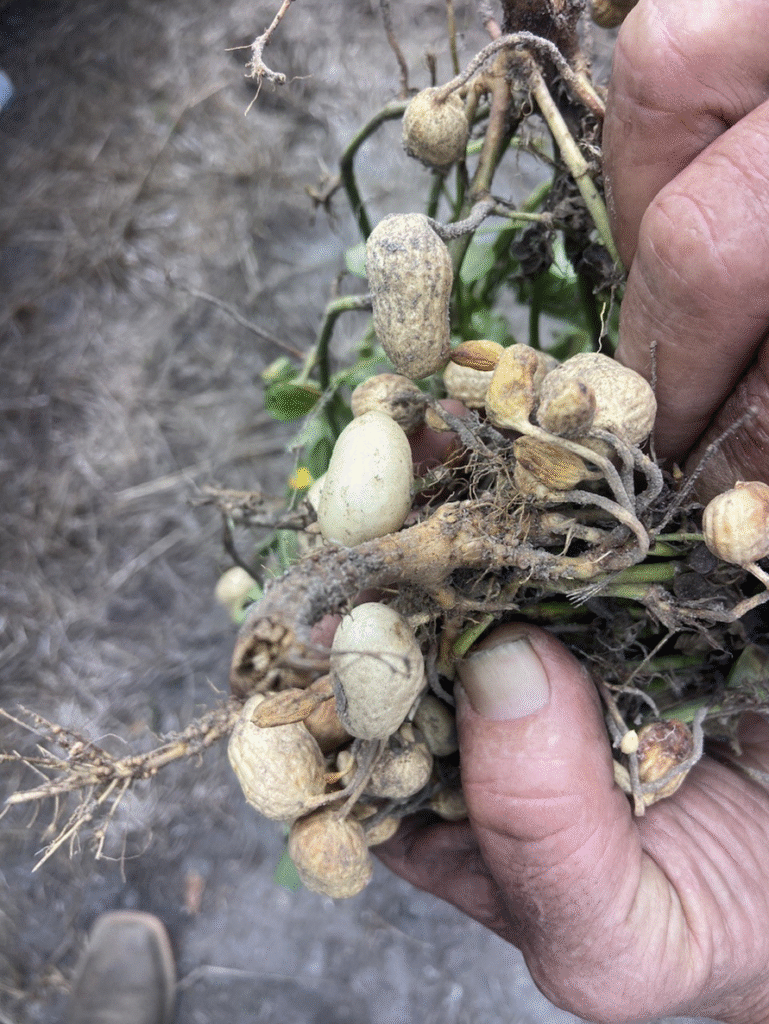
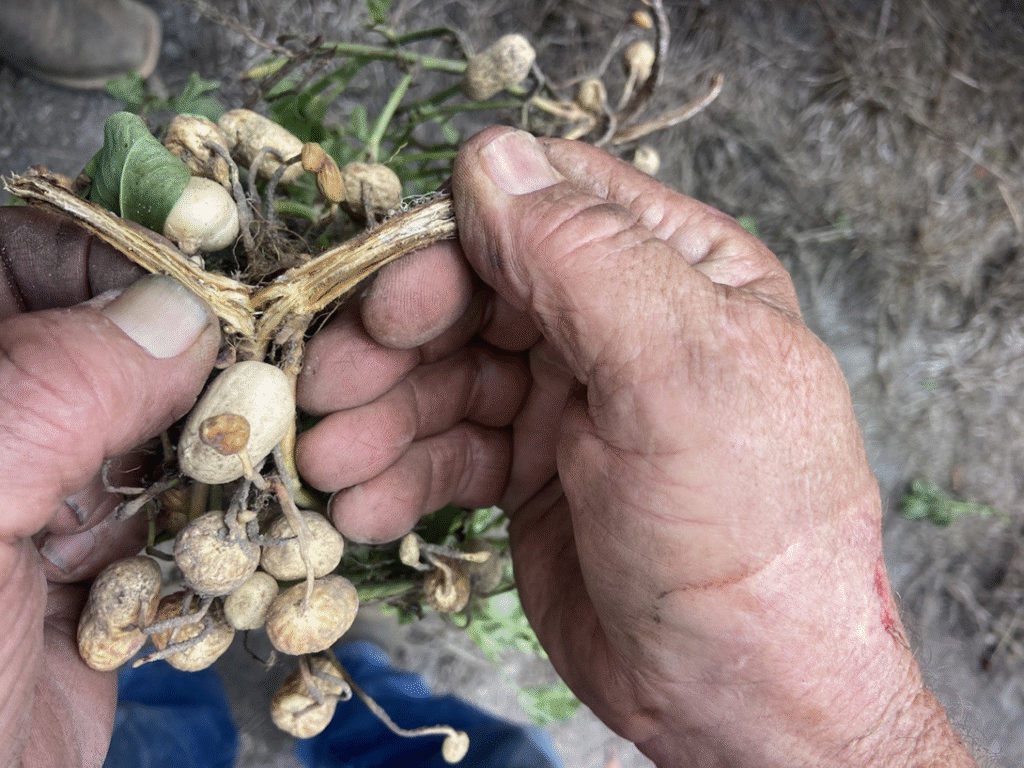
Downey Mildew of Soybean
Soybeans with yellow spots on top and gray fuzzy growth underneath. This is soybean downy mildew. Not a thing to worry about; no spray needed. Charlie Mike; continue the mission.
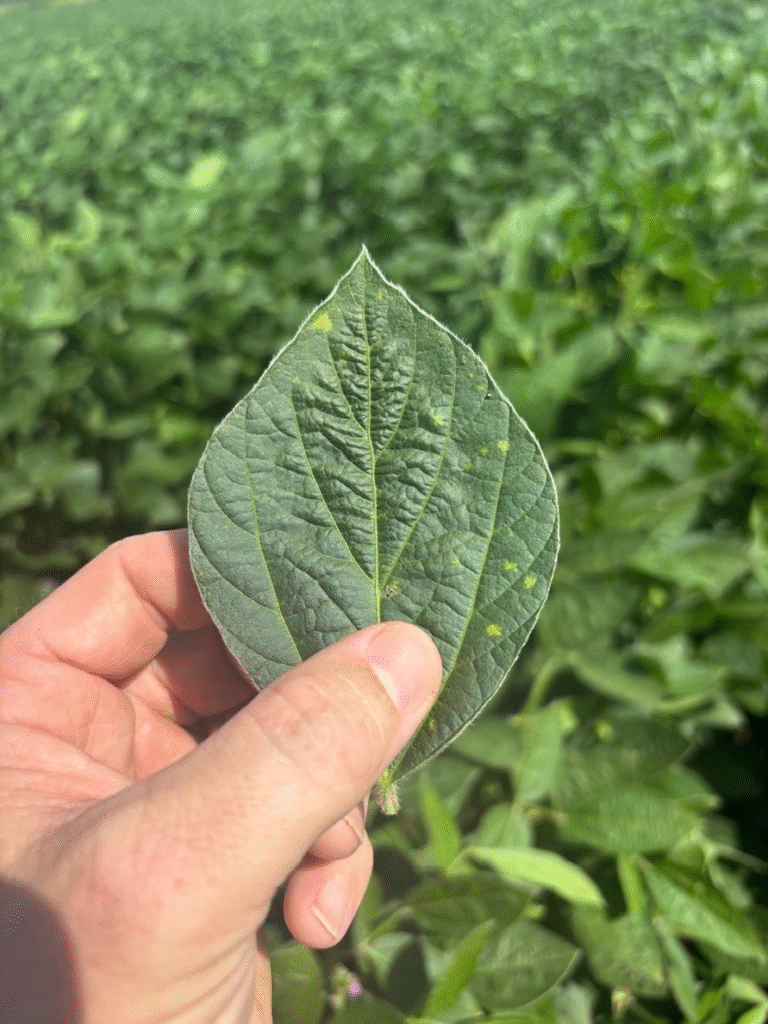
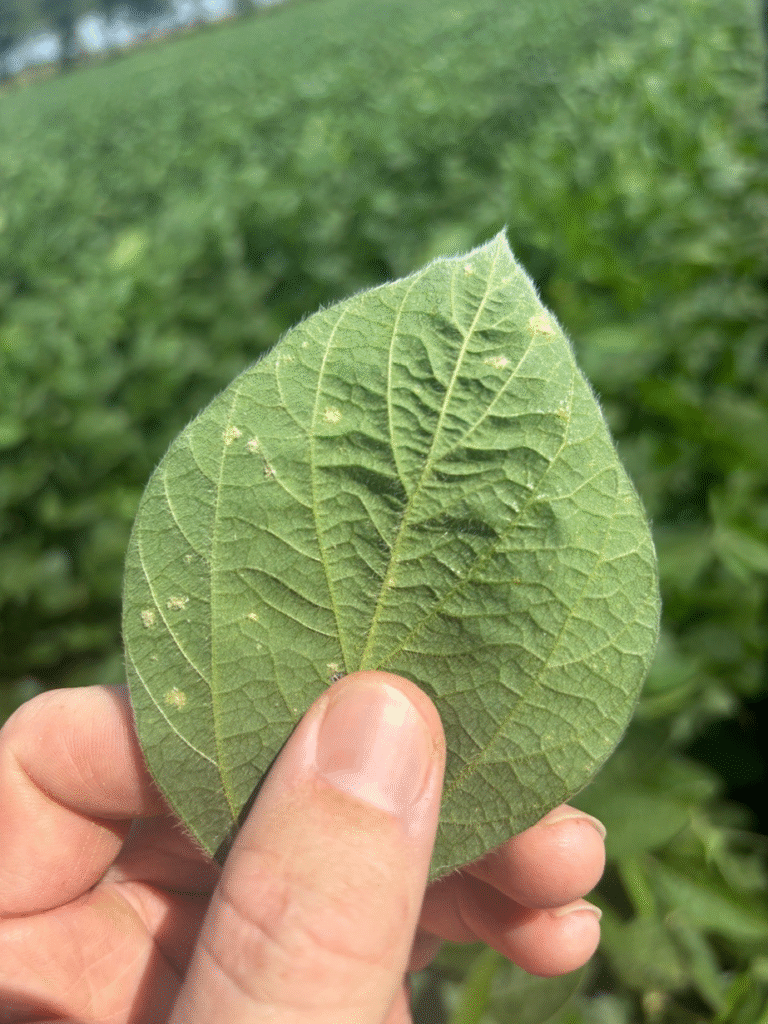
CLRDV-induced Bronze Wilt of Cotton
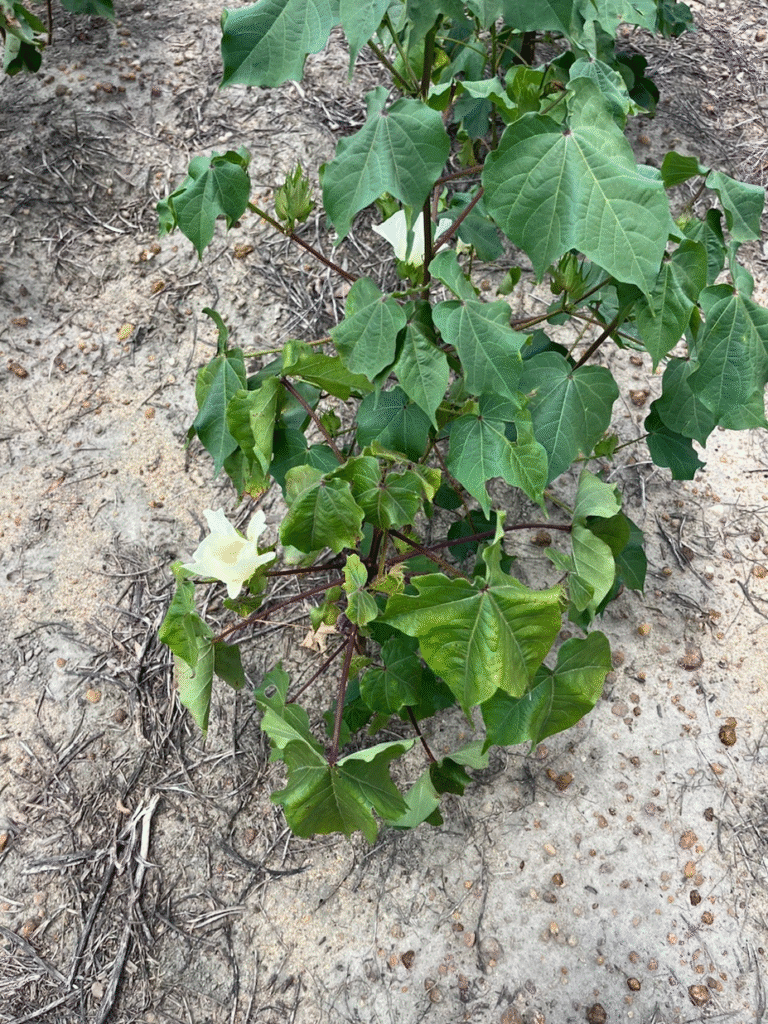
White Mold of Peanut
White mold breaking free. The white mold at this stage is a bit cryptic- smoldering like a cigarette butt stuck in the cushions of a couch. Silent. But at some point, it will ignite. If white mold is not stopped now, as in these pictures, it will be very tough to control when it burns down the row. It is white mold weather. I can hear it late every night now chewing on cotton next to Dr Harris’ house…. Get after it.
I talked to Jeremy about the white mold he is seeing in Colquitt Co now. Mostly smaller hits. “Is the fungicide program working, Bob?” he asked me. Yes, it seems to be- NO fungicide program can protect against single plant infections from inoculum in the soil; however ANY and EVERY effective program MUST contain those hits of white mold and keep them from growing from 6 inches to 6 feet.
Timely irrigation and/or rainfall is essential for maximum efficacy of a white mold fungicide. Without rainfall or irrigation, the fungicide tends to get trapped in the dense leaf canopy, and away from the crown of the plant and lower limbs where it is needed for white mold control. Timely rain and irrigation helps to distribute the fungicide from the leaves to additional targets.
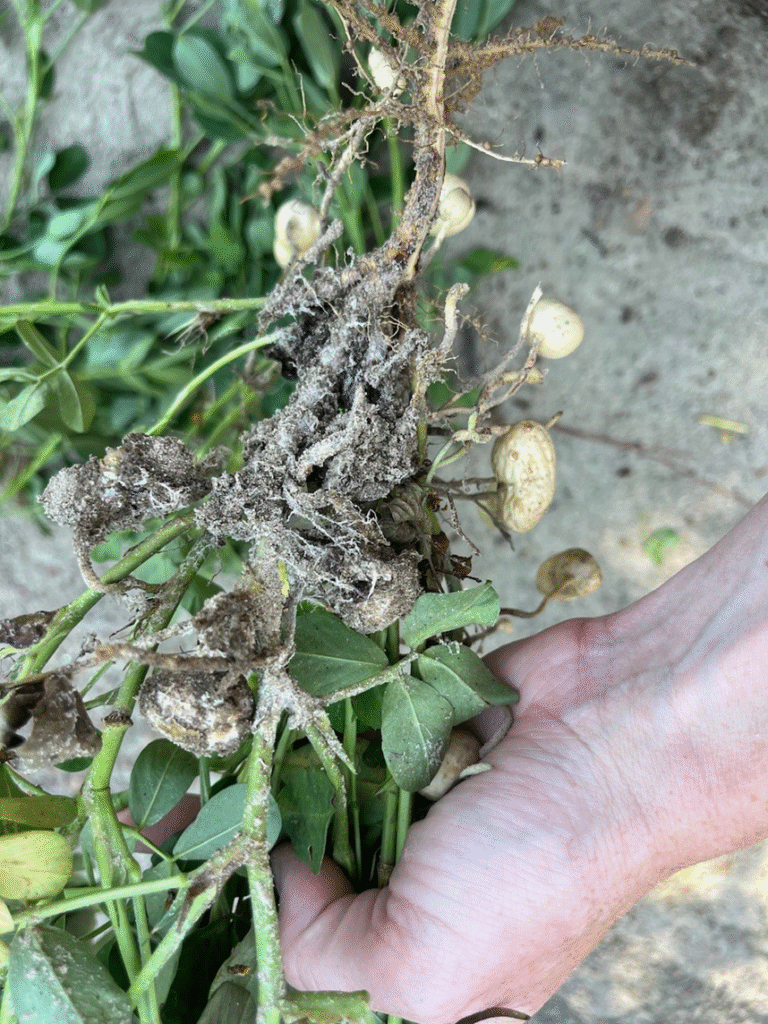
Target Spot of Cotton
Some of the first target spot of cotton I have seen this year. Remind growers that once cotton begins to bloom it is time to watch for target spot. The 3rd week of bloom is an especially important time to check for target spot. My advice holds- “if you can walk through a cotton field at 10:00 AM and you do not find green streaks on your pants, don’t worry about target spot. If you walk through a cotton field at 1:00 PM and end up with green steaks on your khaki pants, it behooves you to think about target spot.
Also…. Areolate mildew will likely be here very soon. Within a month of anticipated defoliation applications, this disease is a threat.
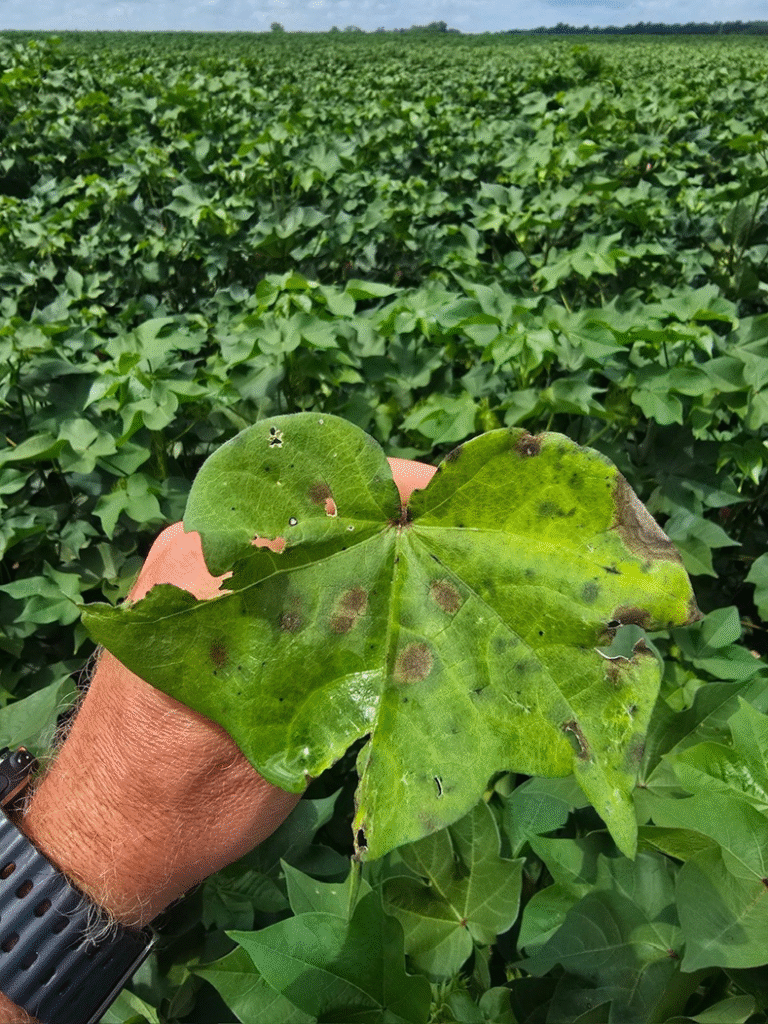
Key points to remember:
1. Depending on the fungicide, you need between 90 minutes and 8 hours of drying time PRIOR to rain or irrigation to ensure good leaf spot control.
2. If leaves are still wet from morning dew when you spray, you need even longer time to ensure adequate leaf spot control.
3. If using a center pivot, I would likely start the pivot by about 6 hours after application; amounts needed to move the fungicide are anywhere from 0.1 to 0.25 inches. This does not have to be “irrigation”.
4. The sooner the better (after appropriate drying time) for irrigation or rainfall to get a white mold benefit. The benefit diminishes quickly with time. After 48 hours there is no benefit.
5. Non-irrigated fields without rainfall can make white mold control tough. My advice- spray at night when leaves are closed or spray when dew is on the plants (recognizing this could negatively impact leaf spot control.)
White mold is ready for a jail break…
Cotton Jassid
Recently an invasive insect was found in Georgia. We are still waiting on identification to be confirmed. The link below will take you to a pest alert released in Florida in 2024. They refer to the pest as the two spot cotton leafhopper. I personally prefer to call it cotton Jassid.
https://ccmedia.fdacs.gov/content/download/117692/file/two-spot-cotton-leaf-hopper-pest-alert.pdf
| PEST ALERT: Two-spot cotton leafhopper serious pest of cotton and several other important crops. This species is problematic wherever it occurs, implied by an old synonym Empoasca devastans Distant, 1918. It is also known as “cotton jassid”, jassid being an old name for small leafhoppers, and also the okra leafhopper, a name commonly used in the Caribbean where okra is an important crop. It was first detected in the U.S. Virgin … ccmedia.fdacs.gov |
These jassids are very small leafhoppers. Adults are recognized by a black dot on each wing. If you observe in your county please let us know.
The initial detection was made by Justin Odom in Seminole county. Additional detections were made by Cale Cloud in Grady, and Will Brown in Appling county.
Recent Peanut Problems (Copperleaf, Roundup, Mixing Order, 2,4-DB Rain-Free Period) (Dr. Eric Prostko, UGA Weed Specialist)
A few interesting things that crossed my path over the last few weeks:
1) From Macie Mosteller in Turner County. Hophornbeam copperleaf in peanut. Way too big now for herbicides (but not hands or hoes). Ultra Blazer (acifluorfen) and Cobra (lactofen) are 2 POST control options for smaller copperleaf plants. Check out this older fact sheet for more info about hophornbeam copperleaf in peanut:
https://secure.caes.uga.edu/extension/publications/files/pdf/C%20882_5.PDF

2) From former legendary Dodge Co. Agent Greg Slaughter (now with RW Griffin). Roundup (glyphosate) contamination on peanut. Grower sprayed Cadre (imazapic) + 2,4-DB + Basagran (bentazon) + Dual Magnum (s-metolachlor) + COC. Sadly, this happens a lot (too much) in south Georgia. Tissue samples sent to Waters Lab in Camilla confirmed the presence of glyphosate (0.3 ppm). How did it get there? Jug management????? Check out this older fact sheet for more info about peanut tolerance to glyphosate:

3) From Bill Tyson in Bulloch Co. The tank-mix blues strike again! Mixing order is important!! A slight change in mixing order helped fix this problem. Check labels for proper mixing orders. Tons of good info in those labels!

4) It has come to my attention that the rain-free period for 2,4-DB listed in the peanut section of the 2025 UGA Pest Control Handbook of 1 hour (page 222) is NOT correct. Not sure where I came up with the 1 hour since nothing specific is listed on any label nor is it consistent with other sources? After talking with technical folks at Albaugh, LLC (makers of Butyrac 175 or Butyrac 200), the rain-free period for 2,4-DB should be 6 hours.
Grains Team | Social Media | Outreach & Educational Programming (Dr. Nick Shay, UGA Grains Agronomist)
Over the past week I have received several inquiries about corn irrigation termination. Thanks to Ross Greene, Sarah Beth Thompson, and Dr. Wes Porter, we have provided a document that you should have seen come through this past week. To further cement this topic, the Grains Team has put together a short video.
Now, after a conversation with a seasoned member of our extension team, it came to my attention that I have failed to provide recent updates on the activity of the Grains Team (unless you stop by or call me).
For those who have not been actively thumb scrolling Facebook, X, LinkedIn, and YouTube, the Grains Team has done a soft launch of our social media outreach and educational programming. Please find all links below or search georgiagrainsteam.
Follow, like, comment, and share with your community. The more you engage, the more impact we will have in our communities – you know how that algorithm works. We hope that you will find it insightful, engaging, and entertaining.
X: https://x.com/UGA_GrainsTeam
FaceBook: https://www.facebook.com/profile.php?id=61576391392580
Instagram: https://www.instagram.com/georgiagrainsteam/
LinkedIn: https://www.linkedin.com/in/georgia-grains-team-81bbb6368/
Midville Field Day (SEREC)
All About the Pod Podcast (UGA Peanut Team)
EPISODE 21, Season 3
In this episode, Dr. Scott Monfort talked peanuts with Dr. Mark Abney, Dr. Scott Tubbs, Dr. Eric Prostko, Dr. Bob Kemerait, Dr. Tim Brenneman, and peanut specialists/faculty from Virginia, North Carolina, South Carolina, Florida, Mississippi, Arkansas, and Texas. In this episode, the peanut team talked about the current crop situation in a majority of the peanut-producing states in the USA up to mid-July.
Talkin’ Cotton Podcast (UGA Cotton Team)
Below is a link to the latest episode of the Talkin’ Cotton Podcast. Feel free to distribute far and wide, and if you have questions please holler.